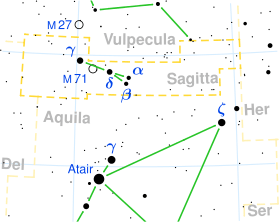Gamma Sagittae

| |
| Observation data Epoch J2000.0 Equinox J2000.0 (ICRS) | |
|---|---|
| Constellation | Sagitta |
| Right ascension | 19h 58m 45.42863s [1] |
| Declination | +19° 29′ 31.7281″ [1] |
| Apparent magnitude (V) | +3.47 |
| Characteristics | |
| Spectral type | M0III |
| Astrometry | |
| Radial velocity (Rv) | -34.00 ± 0.2[1] km/s |
| Proper motion (μ) | RA: 66.21 ± 0.14[2] mas/yr Dec.: 22.22 ± 0.12[2] mas/yr |
| Parallax (π) | 12.62 ± 0.18[2] mas |
| Distance | 258 ± 4 ly (79 ± 1 pc) |
| Absolute magnitude (MV) | -2.13[3] |
| Details | |
| Radius | 55[3] R☉ |
| Luminosity | 562±75[3] L☉ |
| Temperature | 3805[3] K |
| Metallicity | -0.14[3] |
| Other designations | |
Gamma Sagittae (Gamma Sge, γ Sagittae, γ Sge) is the brightest star in constellation Sagitta and is a red giant with an apparent magnitude of +3.47. It is approximately 258 ± 4 light years from Earth. It has been classified as anywhere from spectral type K5III to M0III.[4]
It radiates at a power 640 times that of Sun. With a mass of 2.5 times that of the Sun, Gamma Sagittae began life 750 million years ago as a white class B9 star.[4]
Naming
In Chinese, 左旗 (Zuǒ Qí), meaning Left Flag, refers to an asterism consisting of γ Sagittae, α Sagittae, β Sagittae, δ Sagittae, ζ Sagittae, 13 Sagittae, 11 Sagittae, 14 Sagittae and ρ Aquilae. Consequently, γ Sagittae itself is known as 左旗五 (Zuǒ Qí wǔ, English: the Fifth Star of Left Flag.)[5]
References
- 1 2 3 SIMBAD, Gamma Sagittae (accessed 22 May 2015)
- 1 2 3 van Leeuwen, F. (2007). "Validation of the New Hipparcos Reduction". Astronomy and Astrophysics. 474 (2): 653–64. arXiv:0708.1752
 . Bibcode:2007A&A...474..653V. doi:10.1051/0004-6361:20078357.
. Bibcode:2007A&A...474..653V. doi:10.1051/0004-6361:20078357. - 1 2 3 4 5 Piau, L.; Kervella, P.; Dib, S.; Hauschildt, P. (2011). "Surface convection and red-giant radius measurements". Astronomy and Astrophysics. 526: 12. arXiv:1010.3649
 . Bibcode:2011A&A...526A.100P. doi:10.1051/0004-6361/201014442. A100.
. Bibcode:2011A&A...526A.100P. doi:10.1051/0004-6361/201014442. A100. - 1 2 Kaler, James B. "GAMMA SGE (Gamma Sagittae)". Stars. University of Illinois. Retrieved 22 May 2015.
- ↑ (Chinese) AEEA (Activities of Exhibition and Education in Astronomy) 天文教育資訊網 2006 年 7 月 3 日